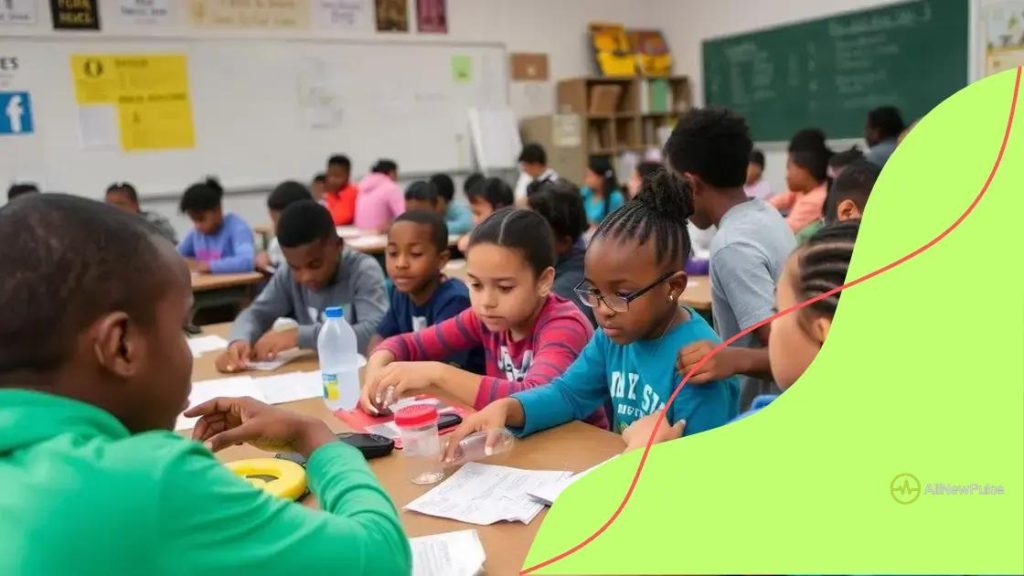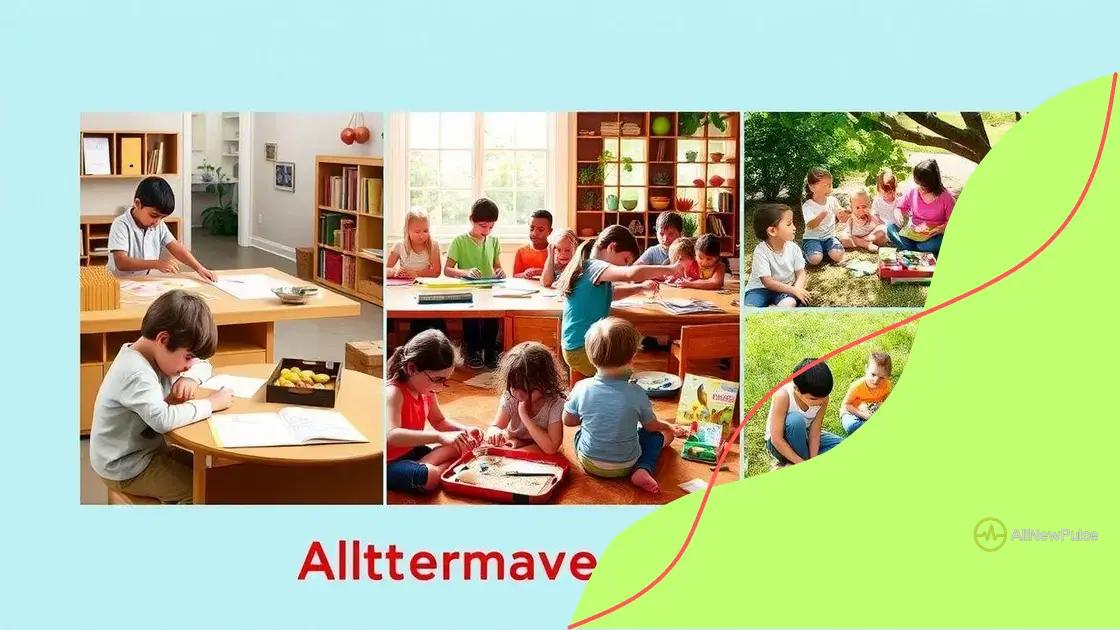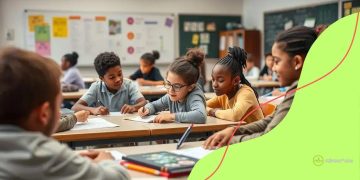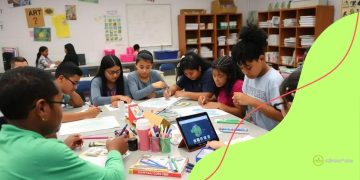Exploring alternative education models: a fresh approach

Exploring alternative education models provides diverse and innovative approaches tailored to individual student needs, fostering engagement, creativity, and critical thinking through personalized learning and technology integration.
Exploring alternative education models opens up new possibilities for students and educators alike. Have you ever wondered how different learning environments can impact a child’s development? In this article, we’ll dive into various approaches that could challenge traditional educational norms.
What are alternative education models?
Alternative education models provide unique approaches to learning, focusing on diverse needs and experiences. These models challenge traditional schooling by offering tailored solutions that often foster creativity and critical thinking.
Key Characteristics of Alternative Education Models
Many of these models share common traits that set them apart from mainstream education.
- Individualized Learning: Students often learn at their own pace, allowing them to fully grasp concepts.
- Holistic Development: Emphasis on emotional and social skills alongside academic achievement.
- Flexible Curriculum: Learning materials and activities can be modified based on students’ interests.
- Collaborative Learning: Encourages teamwork and peer interaction, enhancing social skills.
One significant aspect of alternative education is its focus on the learner’s interests. For instance, students may choose projects that resonate with them, leading to deeper engagement. This approach often meets the diverse needs of students who may feel out of place in traditional classrooms.
Types of Alternative Education Models
There are various models that schools and educators adopt. Here are a few popular options: Montessori Method focuses on self-directed activity, hands-on learning, and collaborative play. Students are encouraged to explore and learn through experience. Waldorf Education emphasizes imagination and creativity, integrating arts and academics to cultivate well-rounded development. Unschooling allows learners to pursue their interests, shifting the power of learning directly to the student.
As these models gain popularity, more families and educators explore their benefits. Alternative education presents an opportunity for students to thrive, especially those who may struggle in conventional settings. By fostering environments that prioritize the individual, schools can create inclusive spaces for all learners.
Benefits of exploring alternative education
Exploring alternative education offers numerous advantages for students, educators, and parents alike. By focusing on individual needs, these models can lead to more fulfilling learning experiences.
Personalized Learning Experience
One of the main benefits is the ability to create a personalized learning experience. Students can progress at their own pace, allowing them to truly master subjects before moving on. This approach often reduces stress and often leads to better retention of information.
- Enhances Engagement: When students have a say in their learning, they are more likely to stay engaged.
- Boosts Confidence: Achieving personal learning goals can significantly increase a student’s confidence.
- Encourages Critical Thinking: Alternative models often promote inquiry and problem-solving, which nurtures critical thinking skills.
The flexibility in curriculum design is another significant advantage of alternative education. Unlike traditional systems, which often follow a strict set of standards, these models can adapt to the interests and abilities of the learners. This can create a more enjoyable and relevant educational journey.
Strong Community Connections
Many alternative education settings foster strong community connections. Students often work together on projects and engage with adults in their community, creating a sense of belonging. Collaboration not only enriches the learning experience but also helps students develop essential social skills.
Furthermore, by being part of a community-focused learning environment, students can see the real-world application of their studies. This is particularly important in today’s world, where cultural and social skills play a critical role in success.
As families explore these non-traditional options, they find that alternative education often leads to happier, more motivated learners. The adaptive nature of these models helps to address diverse learning needs and promotes a lifelong love for learning.
Popular alternative education methods

There are several popular alternative education methods that educators and parents are turning to for a more tailored learning experience. Each method offers unique benefits and approaches that cater to different learning styles and needs.
Montessori Method
The Montessori method emphasizes independent, hands-on learning. In this approach, children choose activities that interest them, allowing them to explore topics at their own pace. This fosters a love for learning by encouraging exploration and curiosity.
- Self-Directed Learning: Children learn through guided choices.
- Mixed Age Groups: Older students help younger ones, promoting collaboration.
- Prepared Environment: Classrooms are designed to facilitate exploration.
Montessori schools often have multi-age classrooms and a focus on real-life skills, blending academic and practical learning.
Waldorf Education
Waldorf education, founded by Rudolf Steiner, integrates arts and academics while focusing on fostering creativity. Lessons often include storytelling, music, and crafts to enrich learning experiences.
In Waldorf schools, the curriculum is designed to synchronize with a child’s developmental stages. This approach helps nurture intellectual, emotional, and practical skills in a well-rounded manner, benefitting multiple aspects of child development.
Unschooling
Unschooling is a learner-centered approach where students direct their own education based on their interests and passions. There are no standardized tests or prescribed curriculums, allowing for a more fluid and individualized learning experience.
This method helps students develop critical thinking and self-motivation. By pursuing their passions, learners often become more engaged and retain information better.
As you can see, popular alternative education methods offer various ways to approach learning. From Montessori to Waldorf and unschooling, each model provides distinct advantages that can cater to the diverse needs of students.
Real-world examples of alternative education
Real-world examples of alternative education showcase how these models can thrive outside traditional settings. Schools and families across the globe are adopting innovative approaches to learning that cater to students’ unique needs.
Sudbury Valley School
Sudbury Valley School in Massachusetts is a prime example of a democratic school where students of all ages share the responsibility for their education. The school’s philosophy is simple: students decide what they want to learn and how they want to spend their time. This empowers children to explore their interests freely.
Here, students develop decision-making skills and learn to engage in community responsibilities. The environment encourages active participation, fostering self-motivation.
High Tech High
High Tech High in California is known for its project-based learning model. Students work on real-world projects that connect deeply with their interests and the community.
- Collaboration: Students often collaborate with local businesses and organizations on projects.
- Hands-On Learning: Emphasis on practical skills and problem-solving.
- Mentorship: Students receive guidance from teachers and community members.
This approach allows students to apply their knowledge in meaningful ways, enhancing their understanding and appreciation of various subjects.
Montessori Schools
Across the globe, countless Montessori schools embody the principles of alternative education. In these settings, children learn in a prepared environment that promotes independence and self-directed learning.
Students engage in hands-on activities and can choose their work, which fosters intrinsic motivation. This method not only develops academic skills but also supports emotional and social growth.
These real-world examples illustrate that alternative education is not just a trend, but a viable solution to meeting the diverse needs of learners. From Sudbury Valley to High Tech High, innovative models are paving the way for a more personalized and engaging educational experience.
Future trends in education innovation
The future of education innovation is bright, with exciting trends on the horizon that aim to enhance learning experiences. As we embrace new technologies and ideals, new educational approaches are emerging to meet the needs of diverse learners.
Technology Integration
One significant trend is the integration of technology in classrooms. Schools are adopting tools like virtual reality (VR) and augmented reality (AR) to make learning more interactive and engaging. By using these technologies, students can explore environments and concepts that would otherwise be out of reach.
- Virtual Field Trips: Students can visit historical sites or explore the solar system without leaving the classroom.
- Interactive Software: Tailored learning applications adapt to each student’s pace and style.
- Flipped Classrooms: Learners can study at home and engage in hands-on activities during class.
This shift not only enhances understanding but also prepares students for a technology-driven future.
Personalized Learning
Personalized learning continues to gain traction as educators recognize the importance of meeting individual student needs. This approach allows for tailored learning plans that consider each student’s strengths and weaknesses. Customized education can lead to improved academic performance and increased motivation.
In this model, students often set personal goals and have a say in their learning processes. This promotes ownership of their education and helps them develop critical skills for future success.
Focus on Social-Emotional Learning (SEL)
Another emerging trend is the emphasis on social-emotional learning (SEL). Educators are increasingly aware that academic success is closely linked to emotional intelligence. Schools are incorporating SEL programs to help students develop skills like empathy, resilience, and relationship-building.
By prioritizing SEL, schools create supportive environments where students can thrive emotionally as well as academically. This holistic approach impacts not just individual success but also classroom dynamics and school culture.
Overall, these future trends in education innovation are shaping a new landscape for teaching and learning. By embracing technology, personalizing education, and fostering emotional well-being, educators can create a bright future for students.
In conclusion, exploring alternative education models reveals their potential to enrich the learning experience for students. By focusing on personalized learning, integrating technology, and emphasizing social-emotional skills, these educational approaches prepare students for future success. As we move forward, embracing these trends will help create a more inclusive and engaging environment for all learners. The future looks bright with continued innovation in education!
FAQ – Frequently Asked Questions about Alternative Education Models
What are alternative education models?
Alternative education models are unconventional teaching approaches that focus on meeting the diverse needs of students, emphasizing personalized learning and flexibility.
What are some benefits of alternative education?
Benefits include personalized learning experiences, increased student engagement, and a focus on social-emotional skills that foster overall development.
How does technology play a role in alternative education?
Technology enhances alternative education by providing interactive tools, such as virtual reality, that make learning more engaging and accessible.
Can alternative education methods prepare students for the future?
Yes, these methods promote critical thinking, creativity, and problem-solving skills, which are essential for success in a rapidly changing world.





